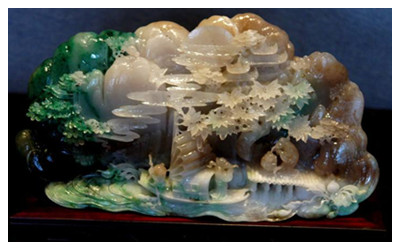
Acknowledged by the world, Jade Carving is one of the oldest carving arts in China. In Shang and Zhou Dynasties, jade carving has become a profession. Jade became a ritual utensils and decorative pieces to wear. Jade has always been treated as treasures. In ancient China, jade is a better product as a symbol of physical signs and gentleman demeanor.
Crude jade tools appeared in China as early as in the late Neolithic Age. And in the primitive society, our ancestries began to make manufacturing jade tools such as knife, shovel, ax and lance and the jade ornaments. Jade carving became an industry in the Shang (16th century BC- 11th century BC) and Zhou (11th BC- 221 BC) dynasties, when skills of jade carving had a further development. Jade wares were used in rituals or as decorative pendants. The jade carving wares were delicate and the ornamental patterns were elegant. In ancient China, jade was also regarded as a symbol of refinement and moral ethics.
Jade is a high-quality stone and has a good many variants. There are white jade, yellow jade, jasper, jadeite, agate, turquoise, etc. Jade carving refers to the process to carve a piece of jade into a fine article of art. A carving artist has to thoroughly examine a piece of jade, cudgel his brains to make a design according to its natural colors and shape, and turn it into an artistic work.
Jade can be carved into human figures, containers, images of birds, animals flowers as well as small things like a brooch, ring, seal or decorative object. What is worth mentioning is the huge jade carving in the Palace Museum in
Beijing. It is called “Da Yu Harnessed Flood”, which is 224 cm in height, 96 cm in width, and about 5300 g in weight. It demonstrated the high skill of Chinese carving artists.
The main producing area of jade wares are
Beijing,
Shanghai,
Guangzhou, Liaoning , Jiangsu , Xinjiang, etc. Chinese jade carving works enjoy a high reputation in the world.

 Acknowledged by the world, Jade Carving is one of the oldest carving arts in China. In Shang and Zhou Dynasties, jade carving has become a profession. Jade became a ritual utensils and decorative pieces to wear. Jade has always been treated as treasures. In ancient China, jade is a better product as a symbol of physical signs and gentleman demeanor.
Acknowledged by the world, Jade Carving is one of the oldest carving arts in China. In Shang and Zhou Dynasties, jade carving has become a profession. Jade became a ritual utensils and decorative pieces to wear. Jade has always been treated as treasures. In ancient China, jade is a better product as a symbol of physical signs and gentleman demeanor. Ask Questions ?
Ask Questions ?